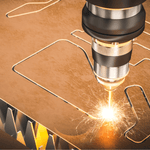
Troubleshooting Cutting Issues- Beginners Guide
Laser cutting acrylic can open up endless creative possibilities—but only when it goes smoothly. If you're running into issues like incomplete cuts, melted edges, warped sheets, or messy results with two-tone acrylic, you're not alone. We hear these questions often, so we’ve compiled the most common laser cutting problems—and how to solve them.
1. Acrylic Not Cutting Through
This is hands-down one of the most frequent complaints. You're expecting a clean cut—and the laser just... doesn’t finish the job.
Possible Causes:
-
Power Too Low: Your machine might not be pushing enough juice. Try increasing the laser power incrementally.
-
Speed Too High: If you’re cutting too quickly, the beam won’t have enough time to fully penetrate.
-
Dirty or Misaligned Lens: Check your optics. Dust or misalignment can reduce cutting performance significantly.
-
Material Masking Interference: Sometimes masking can resist heat and reduce the cut depth. If needed, test with the masking removed.
✅ Pro Tip: Always run a test cut on a small scrap piece to dial in settings—especially if you’re switching materials or thicknesses.
2. Flashback, Char, and Melted Edges
If your cuts are coming out with unsightly marks, rough edges, or melted areas, there are a few culprits at play.
Flashback:
This happens when the laser beam reflects off the metal honeycomb bed back into the acrylic, marking the underside.
Solution:
-
Elevate your material using standoffs, pins, or a pin table.
-
Use a sacrificial sheet beneath your material (like paperboard or non-reflective acrylic).
Char & Melt:
These are generally caused by too much power or not enough air assist.
Solution:
-
Increase your cutting speed.
-
Lower your laser power.
-
Make sure your air assist is functioning properly to cool the material and blow away debris.
3. Warped or Distorted Acrylic
It can be alarming to unpack your sheet and find it's not perfectly flat—but warping isn’t always a defect.
Why It Happens:
-
Chunky Glitter Sheets: Heavier glitter formulations, especially with thick pours or uneven distribution, can warp during cooling. This is a natural byproduct of production.
-
Storage Conditions: Heat, sunlight, or leaning sheets against a wall can cause warping over time.
Solutions:
-
Use weights or magnets to flatten the acrylic while cutting.
-
Store sheets flat and in a cool environment.
4. Sticky Two-Tones or Melty Laminated Products
Two-tone acrylics (engraving-reveal style sheets) require different handling than solid cast or extruded types.
If you’re noticing sticky residue, gooey textures, or overly deep engraving:
Cause:
Your power settings are too high, and you're overburning the laminate layer.
Solution:
Run a test grid to find the lowest effective power setting that cleanly removes the top color without digging into the base.
➡️ Read our full guide on two-tone acrylic:
The Ultimate Guide to Two-Tone Acrylic
5. Edges Are Cloudy or Discolored
Cloudy or matte edges can be a sign of:
-
Cast vs. Extruded Acrylic: Extruded acrylic doesn’t polish as nicely during cutting.
-
Incorrect Focus: If the beam is slightly off-focus, the edge won’t be clean.
-
Low-Quality Air Assist: Without proper airflow, vaporized acrylic recondenses on edges.
✅ Solution:
-
Use cast acrylic for clearer edges.
-
Double-check your focal distance.
-
Upgrade your air assist if you notice smoke buildup.
6. Micro Cracks or Fractures
Some customers notice tiny cracks near the cut edge after a few days. This can be due to:
-
Mechanical Stress during removal or post-processing.
-
Overheating, especially on thin sheets.
Solution:
-
Let sheets cool before removing them.
-
Reduce power or slow down cutting to reduce heat buildup.
Final Tips
-
Keep a settings journal for your materials. Logging your power, speed, and pass settings can save you tons of time in the future.
-
Test before you go big—especially with glitter, mirror, or printed materials.
-
Use high-quality material. Not all acrylics are created equal, and quality differences impact your results more than you’d think.
Got a tricky issue that wasn’t covered here? Drop us a message or join our Acrylic Obsessed Facebook Group for real-time support from thousands of makers who’ve been exactly where you are.
Prev post

Welcome
Updated on 31 December 2023
Next post

Optimizing Your Laser Settings
Updated on 31 December 2023

2 comments
any tips for you white marble – I am getting grey markings on curves and tight corners. BIG Thanks in advance – finger crossed.
Hello, any tips on how to clean the two tone acrylic? After engraving we clean and the top color rubs off.